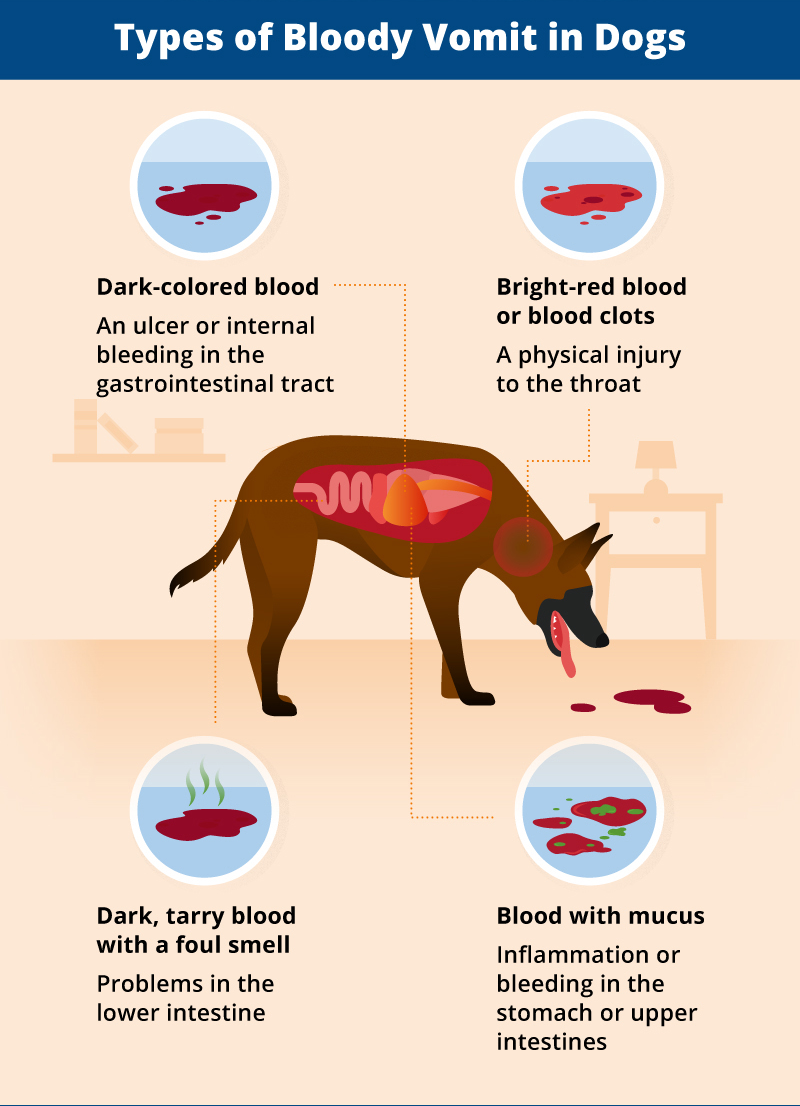Dog Vomiting Blood But Acting Normal
If your dog is vomiting blood and acting normal, don’t panic! While it’s not normal for your dog to vomit blood, it doesn’t necessarily mean something is seriously wrong.
The most important thing to do is to take your dog to the vet so they can determine the cause of the vomiting. In the meantime, here are a few things you can do to help your dog feel better and prevent them from vomiting again.
What Is Vomiting Blood?
Vomiting of blood is a medical emergency. It is also called hematemesis. Many conditions can cause vomiting of blood. For example, it may be due to stomach, esophagus, or upper intestine bleeding. It may also be caused by a tear (laceration) in the esophagus.
When blood is vomited, it may appear bright red or seem like coffee grounds. Coffee ground vomiting is vomit that looks like coffee grounds and is usually a sign of blood in the stomach for some time and has been partially digested.
Vomiting of blood is a medical emergency and should be evaluated by a medical professional immediately.

10 Top Causes of Dogs Vomiting Blood – but Otherwise Acting Normal
The following are ten causes of dogs vomiting blood:
1. Hemorrhagic Gastritis
This condition wherein the stomach’s lining is inflamed and starts to bleed. Commonly seen in dogs that have consumed rat poison or other poisonous substances, a bacterial or viral infection, ulcers, or cancer can also cause hemorrhagic gastritis.
2. Gastric Dilatation Volvulus (GDV)
Also known as bloat, GDV is a life-threatening condition wherein the stomach twists on itself, cutting blood supply. This can cause the stomach to rupture and bleed.
3. Hematemesis
This is simply vomiting blood, which can be caused by any number of underlying conditions, ranging from something as simple as gastritis to more severe issues like cancer.
4. Intestinal Torsion
This condition wherein the intestines become twisted, cutting off their blood supply. Intestinal torsion is a medical emergency and can be fatal if not treated immediately.
5. Parvovirus
A highly contagious and often fatal, parvovirus primarily affects young puppies. Symptoms include vomiting, diarrhea, dehydration, and blood in the stool.
6. Pancreatitis
Inflammation of the pancreas can lead to vomiting blood and abdominal pain, dehydration, and fever. Pancreatitis can be caused by anything from infection to pancreatic cancer.
7. Liver Disease
The liver disease can cause several symptoms, including vomiting blood. Liver disease is often chronic and can be caused by anything from infection to cancer.
8. Kidney Disease
Kidney disease can also cause several symptoms, including vomiting blood. Kidney disease is often chronic and can be caused by infection or cancer.
9. Cancer
Cancer is a leading cause of death in dogs and can cause various symptoms, including vomiting blood.
10. Foreign Body Obstruction
When a dog swallows something it shouldn’t, it can get stuck in its digestive tract and cause vomiting, abdominal pain, bloating, and loss of appetite. If you think your dog may be vomiting blood, it is essential to take them to the vet immediately, as this can signify a severe condition.
Also Read: 15 Symptoms Of Final Stages Of Canine Lymphoma
Diagnosis of Vomiting of Blood In Dogs
If your dog is vomiting blood, the first thing you should do is remain calm. Next, the veterinarian will need to find the source of the bleeding and determine whether your dog has an ulcer, tumor, foreign object, or other health condition.
A physical examination, diagnostic tests, and x-rays may be needed. Treatment of Vomiting of Blood In Dogs Treatment will be based on the underlying cause of the vomiting. For example, if your dog has an ulcer, the veterinarian will likely prescribe medication to reduce the amount of acid in the stomach and promote healing. If a foreign object is a cause, surgery may be needed to remove it. If your dog has a tumor, treatment will depend on the type and stage of cancer.
Treatment of Vomiting of Blood In Dogs

If your dog is vomiting blood, it is essential to seek emergency veterinary care. Depending on the cause of the bleeding, treatment may vary. For example, surgery may be necessary if your dog has an ulcer or cancer.
If the bleeding is due to an infection, antibiotics may be prescribed. In some cases, blood transfusions may be necessary. Treatment will also be based on the severity of the bleeding and whether your dog is showing other signs of illness.
Recovery Of Vomiting 0f Blood In Dogs
If necessary, your dog will likely be hospitalized and treated with intravenous fluids and blood transfusions. With proper treatment, most dogs recover from vomiting blood.
However, some dogs may have a more severe condition that requires additional treatment or surgery.
If your dog is vomiting blood, it is essential to take him to the veterinarian immediately for diagnosis and treatment.
Your dog may be diagnosed with a condition called hemorrhagic gastroenteritis (HGE), which is a potentially life-threatening condition that is characterized by vomiting and bloody diarrhea. HGE is most commonly seen in young, small breed dogs, and is thought to be caused by a sudden, severe drop in blood pressure. Treatment of HGE generally requires hospitalization and aggressive supportive care, including intravenous fluids and blood transfusions.
Tips for Dog Owners
1. Keep your dog hydrated. Offer your small dog sips of water or ice chips to help them stay hydrated. However, avoid giving your dog too much water at once, as this can make them vomit again.
2. Give your bland dog food. If your dog is hungry, offer them a small amount of boiled chicken or rice. Avoid giving them anything else to eat or drink, as this could worsen their vomiting.
3. Keep an eye on your dog’s vomit. If your dog vomits more than once or their vomit is bloody or black, this could be a sign of a more severe problem, and you should take them to the vet immediately.
4. Prevent your dog from exercising. Avoid letting your dog run or play until they’re feeling better. Too much activity can make them vomit again.
5. Monitor your dog’s behavior. For example, if your dog seems to be in pain or is acting unusually lethargic, this could be a sign of a more severe problem, and you should take them to the vet immediately.
Conclusion
Although dog vomiting blood is a potentially serious condition, it is encouraging that your dog is acting normally. However, if your dog is vomiting blood, it is essential to seek veterinary care immediately. With prompt treatment, many dogs make a full recovery.
FAQs On Dog Vomiting Blood But Acting Normal
1.Can a dog throw up blood and be fine?
No, seeing blood in your dog’s vomit is not normal and you should always contact your veterinarian. Even if your dog seems fine otherwise, throwing up blood can indicate a serious underlying condition.
2. How do you treat a dog that vomits blood?
Treatment varies: Depending on the cause, treatment could involve medication, dietary changes, or even surgery
3. Can food poisoning cause a dog to vomit blood?
Yes, food poisoning can be a cause of a dog vomiting blood.
4. Can worms cause a dog to vomit blood?
While uncommon, worms can irritate the digestive tract in dogs, potentially leading to vomiting, but vomiting blood caused by worms is less frequent
